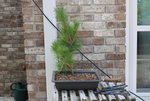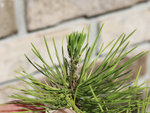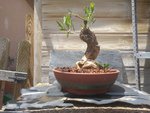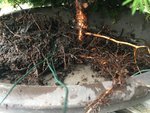Brian Van Fleet
Pretty Fly for a Bonsai Guy
Last year, this thread sparked discussion about the merits of late-summer repotting. Instead of replying there again, I thought I’d start a new thread.
While that thread’s OP calls it “late summer repotting”, often that process is described/shown as shifting a tree from one vessel to another without any root-pruning, and minimal soil removal. In this particular thread, the soil was changed out, but no root pruning was done, and the OP issued these caveats:
“Warning: all this refers to the climate in the south of Germany. ... Mind you: we have not cut off a single living root nor have we cut off a single little branch. This is very important. it helps the tree to grow immediately and establish a healthy root system in the new pot. This was August 5 and the weather forecast is mild with some moisture within the next two weeks.”
My view on repotting, is that the roots below are as important as the tree above. A good bonsai is built from the bottom-up. That is why I named my site “Nebari Bonsai”, as a constant reminder to myself that the best bonsai are built on a good nebari, and it’s something that I’m always chasing. With that approach, I see repotting as a critical and technical window of opportunity to develop and improve the roots. I recognize not everyone shares this view, and that my trees don’t all have perfect nebari.
During the course of the thread, this challenge was issued by a new enthusiast, which got me curious to try summer repotting with a couple commonly-used species to see if it would work:
Below are the results of my experiment. This may not be a large enough sample size for some, or scientific enough for others. But I will say the trees were repotted just as I would have done it at my usual time of March, and they were sited and treated exactly the same as the other bonsai of the same species.
While that thread’s OP calls it “late summer repotting”, often that process is described/shown as shifting a tree from one vessel to another without any root-pruning, and minimal soil removal. In this particular thread, the soil was changed out, but no root pruning was done, and the OP issued these caveats:
“Warning: all this refers to the climate in the south of Germany. ... Mind you: we have not cut off a single living root nor have we cut off a single little branch. This is very important. it helps the tree to grow immediately and establish a healthy root system in the new pot. This was August 5 and the weather forecast is mild with some moisture within the next two weeks.”
My view on repotting, is that the roots below are as important as the tree above. A good bonsai is built from the bottom-up. That is why I named my site “Nebari Bonsai”, as a constant reminder to myself that the best bonsai are built on a good nebari, and it’s something that I’m always chasing. With that approach, I see repotting as a critical and technical window of opportunity to develop and improve the roots. I recognize not everyone shares this view, and that my trees don’t all have perfect nebari.
During the course of the thread, this challenge was issued by a new enthusiast, which got me curious to try summer repotting with a couple commonly-used species to see if it would work:
Anyone else in the last three or four weeks that passed since this thread started did any repot of a deciduous broadleaf tree? Even more so, did any of the vocal nay-sayers here if they are based in locations that allow for a late summer repot tried to expand their mind based on facts and their own experimentation? I hope so but I doubt.
Below are the results of my experiment. This may not be a large enough sample size for some, or scientific enough for others. But I will say the trees were repotted just as I would have done it at my usual time of March, and they were sited and treated exactly the same as the other bonsai of the same species.






















